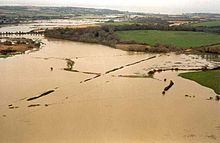
Back Flussaue ALS سهل فيضي Arabic Terrén inundable AST Һыубаҫар туғай Bashkir Atlajė BAT-SMG Пойма Byelorussian Абалона BE-X-OLD Заливна тераса Bulgarian कछार Bihari প্লাবনভূমি Bengali/Bangla






A floodplain or flood plain or bottomlands[1] is an area of land adjacent to a river. Floodplains stretch from the banks of a river channel to the base of the enclosing valley, and experience flooding during periods of high discharge.[2] The soils usually consist of clays, silts, sands, and gravels deposited during floods.[3]
Because of regular flooding, floodplains frequently have high soil-fertility since nutrients are deposited with the flood waters. This can encourage farming;[4] some important agricultural regions, such as the Mississippi river basin and the Nile river basin, heavily exploit floodplains. Agricultural regions, as well as urban areas, have developed near or on floodplains to take advantage of the rich soil and freshwater. However, the risk of inundation has led to increasing efforts to control flooding.
- ^ "Definition of BOTTOMLAND". Archived from the original on 2021-06-14. Retrieved 2021-06-14.
- ^ Goudie, A. S., 2004, Encyclopedia of Geomorphology, vol. 1. Routledge, New York. ISBN 0-415-32737-7
- ^ Kovács, János (2013). "Flood Deposits". Encyclopedia of Natural Hazards. Encyclopedia of Earth Sciences Series. p. 325. doi:10.1007/978-1-4020-4399-4_137. ISBN 978-90-481-8699-0.
- ^ Scott, James C. (22 August 2017). "The Domestication of Fire, Plants, Animals, and ... Us". Against the Grain: A Deep History of the Earliest States. New Haven: Yale University Press. p. 66. ISBN 978-0-3002-3168-7. Retrieved 19 March 2023.
The general problem with farming — especially plough agriculture — is that it involves so much intensive labor. One form of agriculture, however, eliminates most of this labor: 'flood-retreat' (also known as décrue or recession) agriculture. In flood-retreat agriculture, seeds are generally broadcast on the fertile silt deposited by an annual riverine flood.
© MMXXIII Rich X Search. We shall prevail. All rights reserved. Rich X Search